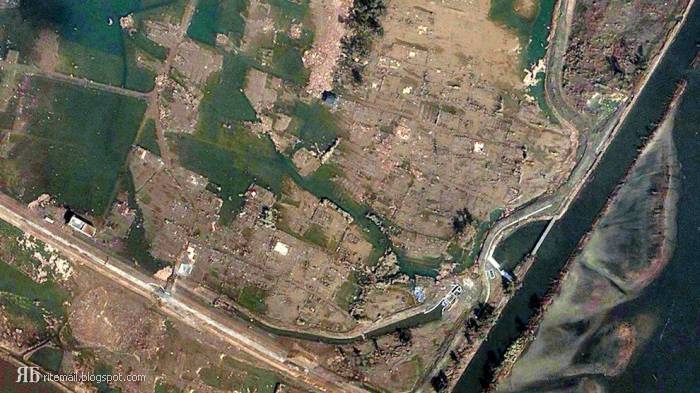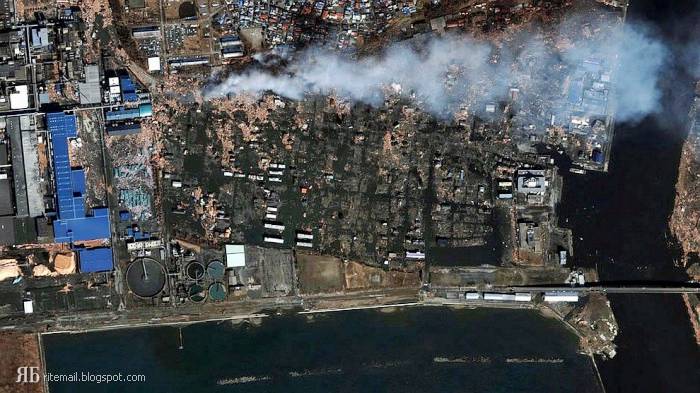A massive 8.8 magnitude quake hit the northeast coast of Japan on Friday

A massive 8.8 magnitude quake hit the northeast coast of Japan on Friday, injuring many,
and triggering major fires.
Updates here:
2:05 pm: Biggest quake since 1995, say Japanese met officials.
2 pm: Blaze continues at major oil refinery. Fires break out in Tokyo as well. Aftershocks
continue in Tokyo.Casualty numbers trickling in.
continue in Tokyo.Casualty numbers trickling in.
1:55 pm: Kudan Kaikan auditorium collapses: 600 had gathered for a graduation ceremony,
30 seriously injured.
30 seriously injured.
1:53 pm: Television studio cameras shake as aftershocks continue.
1:52 pm: Tsunami warnings for Australia, New Zealand.
1:45 pm: Japan's disaster management team is headed by its prime minister Naoto Kan.
One of the biggest earthquakes ever to hit the country, says met office.
One of the biggest earthquakes ever to hit the country, says met office.
Tsunami may hit Indonesia, Hawaii next.
1:26 pm: Japan has swung into disaster control mode following a tsunami and massive
earthquake on Friday.
earthquake on Friday.
The country has shut down all its ports, airports and nuclear installations.
World television channels showed cars and boats being swept onshore by huge tidal waves.
A bigger tsunami is feared.
A bigger tsunami is feared.
Ravi Shingari, director, KPMG, Japan, told CNN-IBN over the phone that the Japanese
were not as shocked by the tremors as the Indians.
were not as shocked by the tremors as the Indians.
The nearest city to the epicenter is the coastal city of Honshu, 130 km (80 miles) from the
quake center. Tokyo is 373 km (231 miles) away.
quake center. Tokyo is 373 km (231 miles) away.
The quake was approximately 24.4 KM deep within the ocean. Al Jazeera is running a
live stream of the disaster:
live stream of the disaster:
Japanese prime minister Naoto Kan said no radiation leak had been reported from any nuclear
installation.
installation.
The authorities had no casualty numbers, and said they were concentrating on 'relief and rescue'.
Thousands of passengers are trapped in trains, which have stopped mid-way. Prime minister Kan
said they would be rescued, and appealed to people in all parts of Japan to be vigilant.
said they would be rescued, and appealed to people in all parts of Japan to be vigilant.
Prime minister Kan is addressing the nation. 'Stay calm', is his message.
The tidal waves were 13 feet high, met reports say.
Buildings in Tokyo shook and made creaking sounds, according to an Indian executive working in
that city.
that city.
An oil refinery is on fire, and the fire authorities are fighting a losing battle.
People are milling around Tokyo station as all trains and buses have been halted.
Stranded passengers can't find any taxis either.
1 pm (India time): All airports have been closed in Japan as the authorities fear fires will break
out following the tsunami.
out following the tsunami.
Japanese public broadcaster NHK showed cars, trucks, houses and buildings being swept away
by the tsunami.
by the tsunami.
Earthquakes are common in Japan, one of the world's most seismically active areas.
The country accounts for about 20 percent of the world's earthquakes of magnitude 6 or
greater.
The country accounts for about 20 percent of the world's earthquakes of magnitude 6 or
greater.
Reuters reports: A massive 8.8 magnitude quake hit the northeast coast of Japan on Friday,
shaking buildings in the capital Tokyo, causing "many injuries", at least one fire and triggering a
four-metre (13-ft)tsunami, NHK television and witnesses reported.
shaking buildings in the capital Tokyo, causing "many injuries", at least one fire and triggering a
four-metre (13-ft)tsunami, NHK television and witnesses reported.
There was also a warning of a 10-metre tsunami following the quake, Japan's biggest in
7 years.
7 years.
The public broadcaster showed flames and black smoke billowing from a building in Odaiba,
a Tokyo suburb, and bullet trains to the north of the country were halted.
a Tokyo suburb, and bullet trains to the north of the country were halted.
Black smoke was also pouring out of an industrial area in Yokohama's Isogo area.
TV footage showed boats, cars and trucks floating in water after a small tsunami hit the town
of Kamaichi in northern Japan.
of Kamaichi in northern Japan.
"The building shook for what seemed a long time and many people in the newsroom grabbed
their helmets and some got under their desks," Reuters correspondent Linda Sieg said.
their helmets and some got under their desks," Reuters correspondent Linda Sieg said.
"It was probably the worst I have felt since I came to Japan more than 20 years ago."
Passengers on a subway line in Tokyo screamed and grabbed other passengers' hands.
The shaking was so bad it was hard to stand, said Reuters reporter Mariko Katsumura.
The shaking was so bad it was hard to stand, said Reuters reporter Mariko Katsumura.

The U.S. Geological Survey earlier verified a magnitude of 7.9 at a depth of 15.1 miles and located
the quake 81 miles east of Sendai, Honshu. It later upgraded it to 8.8.
the quake 81 miles east of Sendai, Honshu. It later upgraded it to 8.8.
The Tokyo stock market extended its losses after the quake was announced. The central bank
said it would do everything to ensure financial stability.
said it would do everything to ensure financial stability.
Japan's northeast Pacific coast, called Sanriku, has suffered from quakes and tsunamis in the past
and a 7.2 quake struck on Wednesday. In 1933, a magnitude 8.1 quake in the area killed more than
3,000 people. Last year fishing facilities were damaged after by a tsunami caused by a strong
tremor in Chile.
and a 7.2 quake struck on Wednesday. In 1933, a magnitude 8.1 quake in the area killed more than
3,000 people. Last year fishing facilities were damaged after by a tsunami caused by a strong
tremor in Chile.
Earthquakes are common in Japan, one of the world's most seismically active areas. The country
accounts for about 20 percent of the world's earthquakes of magnitude 6 or greater.
accounts for about 20 percent of the world's earthquakes of magnitude 6 or greater.











































